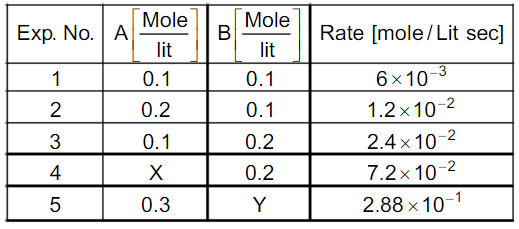X→20682Pb+42He .In this reaction predict the position of group of X:
II B
IV B
VI A
VI B
The correct Answer is:C
To solve the question, we need to analyze the nuclear reaction provided and determine the position of element X in the periodic table.
1. Identify the Reaction: The reaction given is:
X→20682Pb+42He
This indicates that element X decays into lead (Pb) and helium (He).
2. Determine Atomic Numbers:
- The atomic number of lead (Pb) is 82.
- The atomic number of helium (He) is 2.
3. Calculate the Total Atomic Number:
To find the atomic number of element X, we add the atomic numbers of the products:
Atomic Number of X=82+2=84
4. Determine Mass Numbers:
- The mass number of lead (Pb) is 206.
- The mass number of helium (He) is 4.
5. Calculate the Total Mass Number:
To find the mass number of element X, we add the mass numbers of the products:
Mass Number of X=206+4=210
6. Identify Element X:
The element with atomic number 84 is Polonium (Po). Therefore, X is polonium with:
- Atomic Number: 84
- Mass Number: 210
7. Determine the Group of Polonium:
Polonium is located in Group 16 of the periodic table, which is also referred to as Group 6A.
8. Conclusion:
Based on the analysis, the position of group of X (Polonium) is:
Group 6A (or Group 16)
Final Answer:
The correct option for the given question is 6A.
---
X→20682Pb+42He
This indicates that element X decays into lead (Pb) and helium (He).
- The atomic number of lead (Pb) is 82.
- The atomic number of helium (He) is 2.
To find the atomic number of element X, we add the atomic numbers of the products:
Atomic Number of X=82+2=84
- The mass number of lead (Pb) is 206.
- The mass number of helium (He) is 4.
To find the mass number of element X, we add the mass numbers of the products:
Mass Number of X=206+4=210
The element with atomic number 84 is Polonium (Po). Therefore, X is polonium with:
- Atomic Number: 84
- Mass Number: 210
Polonium is located in Group 16 of the periodic table, which is also referred to as Group 6A.
Based on the analysis, the position of group of X (Polonium) is:
Group 6A (or Group 16)
The correct option for the given question is 6A.
Similar Questions
Knowledge Check
Ltx→1x3+3x−42x2+x−3 is equal to
A32B65C56Dnone of these
Consider two decay reactions.
(a) _92236U→20682Pb+10pro→ns+20≠utrons (b) _92238U→20683Pb+842He+6e≤ctrons
Are both the reactions possible?
View SolutionThe positions of .21D,.42He and .73Li are shown on the binding energy curve as shown in figure.
_S01_037_Q01.png)
The energy released in the fusion reaction. .21D+.73Li→2.42He+.10n
View SolutionUranium .92U238 decayed to .82Pb206. They decay process is .92U238→.82Pb206xαyβ
t1/2 of U238=4.5×109 years
Atomic mass of U238 is 238.125 amu. Its packing fraction will be
View SolutionWrite the electronic configuration of the following elements and predict the block, period and group to which each element belongs.
J (Z = 82)
View SolutionSiCl4H2O−−→(X)heat−−→(Y)
In the above reaction (X) and (Y) respectively are :
View Solution(a) On analysis a sample of uranium ore was found to contain 0.277g of .82Pb206 and 1.667g of .92U238. The half life period of U238 is 4.51×109 year. If all the lead were assumed to have come from decay of .92U238, What is the age of earth?
(b) An ore of .92U238 is found to contain .92U238 and .82Pb206 in the weight ratio of 1:0.1 The half-life period of .92U238 is 4.5×109 year. Calculate the age of ore.
View SolutionIf (2x4)(x−8)=0 , find the positive value of x
View Solution

